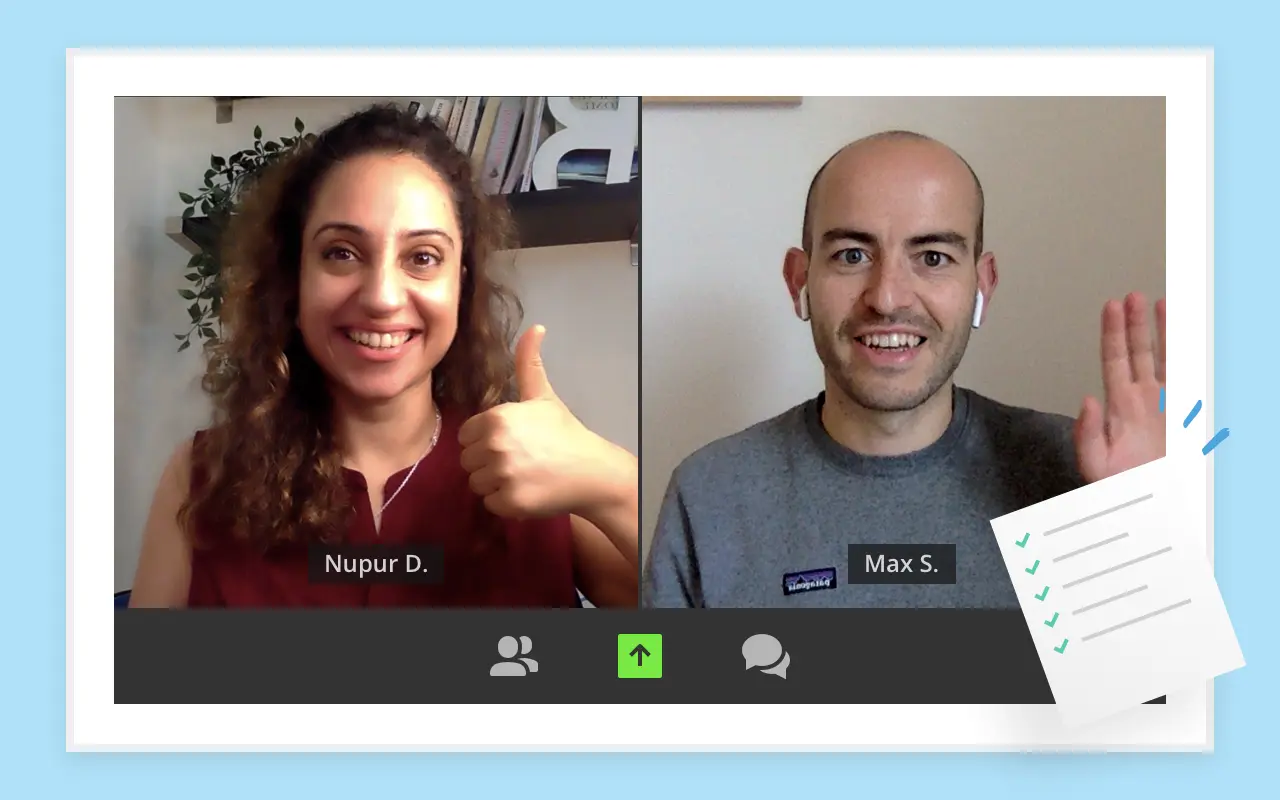Google L4 interviews for engineering candidates are tough.
You'll need to prepare thoroughly, and we're not just talking about spending day after day on Leetcode: with 3-4 interview rounds, you'll be deeply tested on a wide range of skills.
While you’ll need to demonstrate top-notch coding skills, you have to pay special attention to coding and behavioral questions during your Google L4 interviews.
The good news is that the right preparation can make a big difference and can help you land a job as an L4 engineer at Google. To help you get there, we’ve put together the ultimate guide below.
Note: This guide is written primarily for L4 software engineering candidates, but most of it will also be relevant if you're an L4 machine learning or data engineering candidate.
Let’s get into it!
Click here to book a 1-on-1 session with an ex-Google interviewer
1. Google L4: Level and salary ↑
Before we cover your Google L4 interviews, let’s take a look at the level you're applying for.
Individual contributor levels for engineers at Google start at L2 and go up to L11.
- L2: Intern
- L3: Entry-level engineer
- L4: Mid-level engineer
- L5: Senior engineer
- L6: Staff engineer
- L7: Senior staff engineer
- L8: Principal engineer
- L9: Distinguished engineer
- L10: Google fellow
- L11: Senior Google fellow
Below, we discuss in detail what a Google L4 engineer does and how much engineers at this level earn on average.
1.1 What does a Google L4 engineer do?
Google L4 engineers are considered mid-level engineers within the company’s technical career ladder.
At this level, Han (ex-Google senior engineering manager) explains that L4 engineers are “given well-defined problems and requirements” and are expected to “build out solutions,” with occasional support from more senior engineers.
Performance at this level is primarily measured by code output. Unlike role equivalents in other companies like Meta (E4) and Amazon (SDE III), Google L4 engineers are not expected to design systems.
Alex (ex-Google engineering manager) adds that at this level, candidates are normally able to make complex contributions to the codebase with multiple merge requests, with designs created and reviewed by senior or staff engineers.
He also notes that some technical leadership skills are expected mainly in the form of mentoring or supporting interns and junior engineers.
Google’s job listings suggest that, in addition to the responsibilities mentioned above, successful L4 software engineer candidates are also expected to:
- Develop software in one or more programming languages
- Work with large-scale systems, performance optimization, data analysis, visualization tools, or debugging
- Apply knowledge of data structures and algorithms in real-world scenarios
- Ensure code and system health, resolving issues, and contributing to software testing and reliability
- Develop accessible technologies
1.2 How much does a Google L4 engineer make?
Google’s competitive salary is among the numerous factors that draw high-performing engineers to the company.
Below are the average salaries and compensation for the different L4 engineers at Google. This is based on the reported data from Levels.fyi.

Ultimately, how well you perform in your interviews will determine what you’ll be offered. That’s why hiring one of our ex-Google interview coaches can provide such a significant return on investment.
And remember, compensation packages are always negotiable, even at Google.
So, if you do get an offer, don’t be afraid to ask for more. If you need help negotiating, use our guide to Google offer negotiations and consider booking one of our salary negotiation coaches to get expert advice.
2. Google L4 interview process and timeline ↑
2.1 What interviews to expect
What's the Google L4 engineer interview process and timeline? It usually takes between two weeks up to four months and follows these steps:
- Resume screen
- Recruiter screen
- Technical screen: 1 x 30-60 minute interview
- Onsite interviews: 3-4 x 45-minute interviews
We’ve laid out the process and typical questions for SWE candidates, but if you’re a different type of L4 engineer, the interview process will follow a similar format.
Let's look at each of these steps in more detail below:
2.1.1 Resume screen
First, recruiters will look at your resume and assess if your experience matches the open position. This is the most competitive step in the process, as most candidates do not make it past this stage.
You can use this software engineer resume guide and browse these Google resume examples to help tailor your resume to the position you’re targeting.
And if you’re looking for expert feedback, you can also get input from our team of ex-Google recruiters, who will cover what achievements to focus on (or ignore), how to fine-tune your bullet points, and more.
2.1.2 Technical screen
The technical screen is a coding interview, testing your knowledge of key data structures and algorithms.
Google sometimes refers to this as a "Technical phone interview" but it usually takes place over Google Meet, as you'll be writing code in a Google doc.
This is how Google says you should approach the technical screen:
- Be prepared to write around 20-30 lines of code in your strongest language. Approach all scripting as a coding exercise — this should be clean, rich, robust code.
- You will be asked an open-ended question. Ask clarifying questions, and devise requirements.
- You will be asked to explain it in an algorithm.
- Convert it to a workable code. (Hint: Don't worry about getting it perfect because time is limited. Write what comes, but then refine it later. Also, make sure you consider corner cases and edge cases, production-ready.)
- Optimize the code, follow it with test cases, and find any bugs.
(Source: Official Google SWE interview PDF)
If, like most of us, you're used to writing code in an IDE that automatically does things like auto-indentation, auto-complete, syntax highlighting, etc., writing syntactically correct code in a Google Doc can be quite uncomfortable. So, practice this ahead of the interview!
Finally, in addition to coding questions, you should also be ready to answer a few typical behavioral questions, including "Tell me about yourself," "Why Google?" or "Tell me about a recent project you worked on."
2.1.3 Onsite interviews
If you pass the tech screen, you’ve made it to the real test: the “onsite” interviews. You'll typically spend a full day at a Google office and do three to four 45-minute interviews in total, consisting of:
- Coding interviews (2 or 3)
- Googleyness interview (1)
We’ll dig deeper into these in Section 3.
Are system design questions part of the L4 interview at Google?
As mentioned in Section 1.1, L4 engineers are not expected to design systems for any projects unless they're closer to the L5 level. Hence, L4 candidates are typically not assessed on system designs.
“For growth opportunities, L4 engineers already working at Google could slowly take on system design opportunities to prepare for an L5 promotion,” says Han.
2.2 What exactly Google is looking for
At the end of each interview, your interviewer will grade your performance using a standardized feedback form that summarizes the attributes Google looks for in a candidate. That form is constantly evolving, but below we've listed the main components we know of at this time of writing.
A) Questions asked
In the first section of the form, the interviewer fills in the questions they asked you. These questions are then shared with your future interviewers so you don't get asked the same questions twice.
B) Attribute scoring
Each interviewer will assess you on the four main attributes Google looks for when hiring:
- General cognitive ability. This is often referred to as "GCA" by Googlers. The company wants to hire smart engineers who can learn and adapt to new situations. Here, your interviewer will try to understand how you solve hard problems and how you learn. For more information, take a look at our guide to the GCA interview.
- Role-related knowledge and experience. This is often referred to as "RRK" or "RRKE" internally. The company wants to make sure that you have the right experience, domain expertise, and competencies for the position you're applying for. For more information, take a look at our guide to the RRK interview.
- Leadership. Google looks for a particular type of leadership called “emergent leadership.” You'll typically be working in cross-functional teams at Google, and different team members are expected to step up and lead at different times in the lifecycle of a project when their skills are needed. More information on this guide to Google leadership questions.
- Googleyness (i.e., culture fit). The company wants to make sure Google is the right environment for you. Your interviewer will check whether you naturally exhibit the company's values, including: being comfortable with ambiguity, having a bias to action, and a collaborative nature. More information on this guide to Googleyness questions.
Depending on the exact job you're applying for, these attributes might be broken down further. For instance, "Role-related knowledge and experience" could be broken down into "Security architecture" or "Incident response" for a site reliability engineer role. But the total number of attributes does not usually exceed six or seven.
In this middle section, Google's interviewers typically repeat the questions they asked you, document your answers in detail, and give you a score for each attribute (e.g., "Poor", "Mixed", "Good", "Excellent").
C) Final recommendation
Finally, interviewers will write a summary of your performance and provide an overall recommendation on whether they think Google should be hiring you or not (e.g., "Strong no hire", "No hire", "Leaning no hire", "Leaning hire", "Hire", "Strong hire").
2.3 What happens behind the scenes
If things go well at your onsite interviews, here is what the final steps of the process look like:
- Interviewers submit feedback
- Hiring committee recommendation
- Team matching
- Senior leader and Compensation Committee review
- Final executive review (only senior roles)
- You get an offer
After your onsite, your interviewers will all submit their feedback, usually within two to three days. This feedback will then be reviewed by a hiring committee, along with your resume, internal referrals, and any past work you have submitted. At this stage, the hiring committee will make a recommendation on whether Google should hire you or not.
If the hiring committee recommends that you get hired, you'll usually start your team matching process. In other words, you'll talk to hiring managers and one or several of them will need to be willing to take you into their team in order for you to get an offer from the company.
In parallel, the hiring committee recommendation will be reviewed and validated by a senior manager and a compensation committee, who will decide how much money you are offered. Finally, if you are interviewing for a senior role, a senior Google executive will review a summary of your candidacy and compensation before the offer is sent to you.
As you've probably gathered by now, Google goes to great lengths to avoid hiring the wrong candidates. This hiring process with multiple levels of validations helps them scale their teams while maintaining a high caliber of employees. But it also means that the typical process can spread over multiple months.
3. Google L4 example interview questions ↑
As explained in Section 2, you'll face three or four 45-minute interviews at the full loop stage covering:
Now, let’s take a closer look at each question type.
3.1 Coding ↑
Google software engineers, especially at the L4 level, solve some of the most difficult problems the company faces with code. It's therefore essential that they have strong problem-solving skills. This is the part of the interview where you want to show that you think in a structured way and write code that's accurate, bug-free, and fast.
In addition to practicing a wide variety of questions on data structure and algorithms, Han shares the following tips when cracking coding questions:
- Master writing efficient code in one programming language
- Ask clarification questions before diving into the solution
- Clearly outline requirements and assumptions, and communicate them with the interviewer
- Choose the right data structures and algorithms, and explain any trade-offs you make
- Write clean, efficient code with minimal mistakes
- Talk through your thought process as you code to keep the interviewer engaged
- Clearly state the time and space complexity of your solution using Big-O notation
Now, let’s get into some practice questions.
Based on our analysis of the 100 most recent software engineer interview questions reported on Glassdoor, here are the most commonly asked coding topics at Google, along with how frequently they come up.
These questions are relevant across levels and should also be helpful for your L4 interview prep.

- Arrays & strings: 42.9%
- Graphs & trees: 33.7%
- Dynamic programming: 11.2%
- Recursion: 6.1%
- Math: 6.1%
Let’s dive into some sample questions:
Google coding interview example questions: arrays & strings
- Implement Trie for prefix matching. (Solution)
- Write a function to merge two sorted arrays without using extra space. (Solution)
- Given an array of integers, return all unique triplets [a, b, c] where a + b + c = 0. Ensure no duplicate triplets in the output. (Solution)
- Write a function that prints out every permutation of 1s and 2s that add up to a number n. (Solution)
- Implement a Snapshot Array that supports pre-defined interfaces (note: see link for more details). (Solution)
- In a row of dominoes, A[i] and B[i] represent the top and bottom halves of the i-th domino. (A domino is a tile with two numbers from 1 to 6 - one on each half of the tile.) We may rotate the i-th domino, so that A[i] and B[i] swap values. Return the minimum number of rotations so that all the values in A are the same, or all the values in B are the same. If it cannot be done, return -1. (Solution)
- Your friend is typing his name into a keyboard. Sometimes, when typing a character c, the key might get long pressed, and the character will be typed 1 or more times. You examine the typed characters of the keyboard. Return True if it is possible that it was your friend's name, with some characters (possibly none) being long pressed. (Solution)
- Given a string S and a string T, find the minimum window in S which will contain all the characters in T in complexity O(n). (Solution)
- Given a list of query words, return the number of words that are stretchy. Note: see link for more details. (Solution)
- Given an array of words and a width maxWidth, format the text such that each line has exactly maxWidth characters and is fully (left and right) justified. (Solution)
- Given an encoded string, return its decoded string. (Solution)
Check out our guides on array interview questions and string interview questions to learn more about the topics.
Google coding interview example questions: graphs & trees
- Implement a cleaning algorithm for a robot vacuum cleaner that doesn't know its position within the room. (Solution)
- Write a code to construct a binary tree that is a mirror of the given binary tree. (Solution)
- Find the lowest common ancestor of two nodes. (Solution)
- Write a function to detect cycles in a directed graph. How would you optimize a database query to improve runtime? (Solution)
- Given a binary tree, find the maximum path sum. The path may start and end at any node in the tree. (Solution)
- We can rotate digits by 180 degrees to form new digits. When 0, 1, 6, 8, 9 are rotated 180 degrees, they become 0, 1, 9, 8, 6, respectively. When 2, 3, 4, 5, and 7 are rotated 180 degrees, they become invalid. A confusing number is a number that, when rotated 180 degrees, becomes a different number with each digit valid. (Note that the rotated number can be greater than the original number.) Given a positive integer N, return the number of confusing numbers between 1 and N inclusive. (Solution)
- Given two words (beginWord and endWord), and a dictionary's word list, find the length of shortest transformation sequence from beginWord to endWord, such that: 1) Only one letter can be changed at a time and, 2) Each transformed word must exist in the word list. (Solution)
- Given a matrix of N rows and M columns. From m[i][j], we can move to m[i+1][j], if m[i+1][j] > m[i][j], or can move to m[i][j+1] if m[i][j+1] > m[i][j]. The task is: print longest path length if we start from (0, 0). (Solution)
- Given a robot cleaner in a room modeled as a grid. Each cell in the grid can be empty or blocked. The robot cleaner with 4 given APIs can move forward, turn left, or turn right. Each turn it made is 90 degrees. When it tries to move into a blocked cell, its bumper sensor detects the obstacle, and it stays on the current cell. Design an algorithm to clean the entire room using only the 4 given APIs shown below. (Solution)
Check out our guides on graph interview questions and tree interview questions to learn more about the topics.
Google coding interview example questions: dynamic programming
- Given two strings, text1 and text2, return the length of their longest common subsequence. If there is no common subsequence, return 0. (Solution)
- Find the minimum number of coins needed for change. (Solution)
- Non-overlapping intervals. (Solution)
- Given a matrix and a target, return the number of non-empty submatrices that sum to target. (Solution)
- Given a rows x cols binary matrix filled with 0's and 1's, find the largest rectangle containing only 1's and return its area. (Solution)
- Your car starts at position 0 and speed +1 on an infinite number line. (Your car can go into negative positions.) Your car drives automatically according to a sequence of instructions A (accelerate) and R (reverse)... Now, for some target position, say the length of the shortest sequence of instructions to get there. (Solution)
- Given strings S and T, find the minimum (contiguous) substring W of S, so that T is a subsequence of W. If there is no such window in S that covers all characters in T, return the empty string "". If there are multiple such minimum-length windows, return the one with the left-most starting index. (Solution)
Check out our guide on dynamic programming interview questions to learn more.
Google coding interview example questions: recursion
- Solve the "Generate All Possible Balanced Parentheses" problem recursively. (Solution)
- Reverse a linked list. (Solution)
- A strobogrammatic number is a number that looks the same when rotated 180 degrees (looked at upside down). Find all strobogrammatic numbers that are of length = n. (Solution)
- Given a binary tree, find the length of the longest path where each node in the path has the same value. This path may or may not pass through the root. The length of path between two nodes is represented by the number of edges between them. (Solution)
- Given the root node of a binary search tree, return the sum of values of all nodes with values between L and R (inclusive). The binary search tree is guaranteed to have unique values. (Solution)
Google coding interview example questions: math
- Evaluate reverse polish notation and return result. (Solution)
- How to connect nodes that randomly appear. (Solution)
- A group of two or more people wants to meet and minimize the total travel distance. You are given a 2D grid of values 0 or 1, where each 1 marks the home of someone in the group. The distance is calculated using Manhattan Distance, where distance(p1, p2) = |p2.x - p1.x| + |p2.y - p1.y|. (Solution)
- You are given two non-empty linked lists representing two non-negative integers. The digits are stored in reverse order, and each of their nodes contains a single digit. Add the two numbers and return it as a linked list. (Solution)
Read our Google coding interview guide to learn more about each type of question. Then, we recommend practicing with this list of 47 coding interview examples in addition to those listed above.
3.2 Googleyness ↑
“Googleyness” is a shorthand way of talking about the attitudes and character traits that Google looks for in its employees. Sundar Pichai, Google’s Chief Executive Officer, summarizes Googleyness in these six phrases:
- “Mission First” - to prioritize the company’s goals
- “Make Helpful Things” - to build products that improve lives
- “Be Bold and Responsible” - to take risks and be willing to try new things
- “Stay Scrappy” - to be resourceful, flexible, and tenacious in the pursuit of solving a challenge
- “Hustle and Have Fun” - to hustle and push forward to get things done, while enjoying the work
- “Team Google” - to work collaboratively and help others succeed
To demonstrate these traits in interviews, Han recommends preparing a few concrete examples from your past experience that show how you:
- Use data to make decisions and communicate recommendations effectively
- Provide constructive feedback and appropriately challenge the status quo
- Demonstrate humility and clear communication
- Collaborate effectively across teams and functions
- Show a consistent pattern of growth in both technical depth and leadership skills
Below, we list sample questions sourced from Meta L4 candidates' reports in Leetcode forums. We changed the grammar and phrasing in some places to make the questions easier to understand.
Example Googleyness questions from Google L4 interviews
- Tell me about a time you had a disagreement with a colleague. How did you handle it and what was the outcome?
- Describe a situation where a project you were working on was reassigned before the deadline. How did you react and what did you do next?
- Give an example of a time you had to influence another team to move a project forward. How did you approach it?
- Tell me about a time your team wasn’t satisfied with your work. How did you respond, and what steps did you take to address the issue?
- Describe a time when you missed a project deadline. How did you manage the situation, and what did you learn from it?
Check out our guides on Googleyness & leadership and Google behavioral interview questions to learn more.
4. Google L4 interview prep ↑
Now that you know what questions to expect, let's focus on how to prepare.
It's no secret that the performance bar at Google is high. Some people even go as far as quitting their jobs to prepare for interviews full-time. This is extreme and not what we recommend doing, but it shows how much effort some candidates are ready to put in.
We've coached more than 15,000 people for interviews since 2018. Below is our five-step prep plan for Google.
4.1 Learn about Google’s culture
Most candidates fail to do this. But before investing tens of hours preparing for an interview at Google, you should take some time to make sure it's actually the right company for you.
Google is prestigious, and it's therefore tempting to ignore that step completely. But in our experience, the prestige in itself won't make you happy day-to-day. It's the type of work and the people you work with that will.
If you know engineers who work at Google or used to work there, it's a good idea to talk to them to understand what the culture is like. In addition, we would recommend reading the following:
- Google's mission statement (by Google)
- Google's values (by Google)
- Google’s company blog (by Google)
- Google strategy teardown (by CBS Insights)
- Google’s (Alphabet’s) Organizational Culture & Its Traits (by Panmore Institute)
4.2 Avoid these common interviewing mistakes
According to Han, these are the most common mistakes candidates make in L4 interviews and how to avoid them:
- Starting to code too quickly. Jumping into code without first clarifying the problem often leads to weak or incorrect answers. Instead, pause, ask questions, and use a structured approach to problem-solving (see our guide on how to get better at coding interviews).
- Faking past experiences. Interviewers can see right through a made-up story. It’s better to be honest and say, “I have not encountered such situations before, but here’s how I would handle it.”
- Not communicating with the interviewer. Communicating with the interviewer helps them understand your thought process and gives them the chance to offer hints, clarify the question, or steer you in the right direction.
4.3 Practice by yourself
As we've outlined above, you'll have to prepare for a few different types of questions when preparing for Google L4 interviews. In this article, we've recommended various deep-dive articles that will help you prepare for each question category.
Here's the complete list, plus a few other resources:
- Resources from Google:
- Coding: Google coding interview prep, how to get better at coding interviews, Google-tagged LC questions (medium to difficult)
- Googleyness & Leadership: Google behavioral interview prep, Googleyness & Leadership interview guide, how to answer “Why Google?”
For more information on the process for a specific engineering role, consult one of our comprehensive interview guides below:
- Google software engineer interview
- Google machine learning engineer interview
- Google data engineer interview
- Google site reliability engineer interview
Once you’re in command of the subject matter, you’ll want to practice answering questions. But by yourself, you can’t simulate thinking on your feet or the pressure of performing in front of a stranger. Plus, there are no unexpected follow-up questions and no feedback.
That’s why many candidates try to practice with friends or peers.
4.4 Practice with peers
If you have friends or peers who can do mock interviews with you, that's an option worth trying. It’s free, but be warned, you may come up against the following problems:
- It’s hard to know if the feedback you get is accurate
- They’re unlikely to have insider knowledge of interviews at your target company
- On peer platforms, people often waste your time by not showing up
For those reasons, many candidates skip peer mock interviews and go straight to mock interviews with an expert.
4.5 Practice with experienced Google interviewers
In our experience, practicing real interviews with experts who can give you company-specific feedback makes a huge difference.
Find a Google interview coach so you can:
- Test yourself under real interview conditions
- Get accurate feedback from a real expert
- Build your confidence
- Get company-specific insights
- Learn how to tell the right stories, better
- Save time by focusing your preparation
Landing a job at a big tech company often results in a $50,000 per year or more increase in total compensation. In our experience, three or four coaching sessions worth ~$500 make a significant difference in your ability to land the job. That’s an ROI of 100x!
Click here to book mock interviews with experienced Google ex-interviewers.















